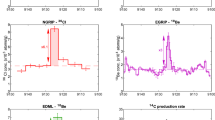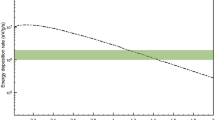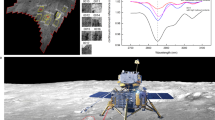Abstract
Lunar rocks and soils undergo long-term irradiation by solar and galactic cosmic rays (SCR and GCR) leading to compositionally-distinct spallation spectra for noble gases1,2 and leaving behind fossil records characteristic of different irradiation features. Because the SCR effects are restricted to the first few millimetres of rocks and soils in contrast to GCR, various studies based on solar flare tracks3,4, thermoluminescence5, and radionuclides3,6 over the past decade have aimed to decipher these fossil records bearing the imprints of the low (SCR) and high (GCR) energy irradiation phenomena. These studies have greatly helped our understanding of the energy spectra and fluxes of charged particles streaming out of the Sun. We have already reported quantitative studies, aimed at isolating the SCR and GCR produced Ne and Ar isotopes in several lunar soils and rocks1,2 and have calculated their solar flare exposure ages which agree with the ‘surface’ exposure ages based on 26Al and particle track studies3. We describe here, for the first time, using 3He in samples from three different depths of lunar rocks, a method for deducing the absolute SCR (flare) proton fluxes in the past few million years which compare favourably with those derived from 26Al and 53Mn studies3,6 of other lunar samples.
This is a preview of subscription content, access via your institution
Access options
Subscribe to this journal
Receive 51 print issues and online access
$199.00 per year
only $3.90 per issue
Buy this article
- Purchase on Springer Link
- Instant access to full article PDF
Prices may be subject to local taxes which are calculated during checkout
Similar content being viewed by others
References
Bhai, N. B., Gopalan, K., Goswami, J. N., Rao, M. N. & Venkatesan, T. R. Proc. 9th Lunar planet. Sci. Conf. 1629–1645 (1978).
Rao, M. N., Venkatesan, T. R., Goswami, J. N., Nautiyal, C. M. & Padia, J. T. Proc. 10th Lunar planet. Sci. Conf. 1547–1564 (1979).
Bhandari, N., Bhattacharya, S. K. & Padia, J. T. Proc. 7th Lunar Sci. Conf. 513–523 (1976).
Arrhenius, G. et al. Proc. 2nd Lunar Sci. Conf. 2583–2589 (1971).
Hoyt, H. P., Jr, Walker, R. M. & Zimmerman, D. W. Proc. 4th Lunar Sci. Conf. 2489–2502 (1973).
Kohl, C. P., Murrell, M. T., Russ III, G.P. & Arnold, J. R. Proc. 9th Lunar planet. Sci. Conf. 2299–2310 (1978).
Eberhardt, P. et al. Proc. 3rd Lunar Sci. Conf. 1821–1856 (1972).
Hohenberg, C. M., Marti, K., Podosek, F. A., Reddy, R. C. & Shirck, J.R. Proc. 9th Lunar planet. Sci Conf. 2311–2344 (1978).
Stettler, A., Eberhardt, P., Geiss, J., Grogler, N. & Maurer, P. Proc. 4th Lunar Sci. Conf. 1865–1888 (1973).
Lugmair, G. W., Marti, K., Kurtz, J. P. & Scheinin, N. B. Proc. 7th Lunar Sci. Conf. 2009–2033 (1976).
Heymann, D., Mazor, E. & Anders, E. Geochim, cosmochim. Acta 32, 1241–1268 (1968).
Reedy, R. C. & Arnold, J.R. J. geophys. Res. 77, 537–555 (1972).
Walton, J.R., Heymann, D., Yaniv, A., Edgerley, D. & Rowe, M. W. J. geophys. Res. 81, 5689–5699 (1976).
Author information
Authors and Affiliations
Rights and permissions
About this article
Cite this article
Rao, M., Venkatesan, T. Solar-flare produced 3He in lunar samples. Nature 286, 788–790 (1980). https://doi.org/10.1038/286788a0
Received:
Accepted:
Published:
Issue Date:
DOI: https://doi.org/10.1038/286788a0
This article is cited by
-
Solar-flare produced 3He in lunar samples
Nature (1981)
-
Solar-flare produced 3He in lunar samples
Nature (1981)
Comments
By submitting a comment you agree to abide by our Terms and Community Guidelines. If you find something abusive or that does not comply with our terms or guidelines please flag it as inappropriate.



